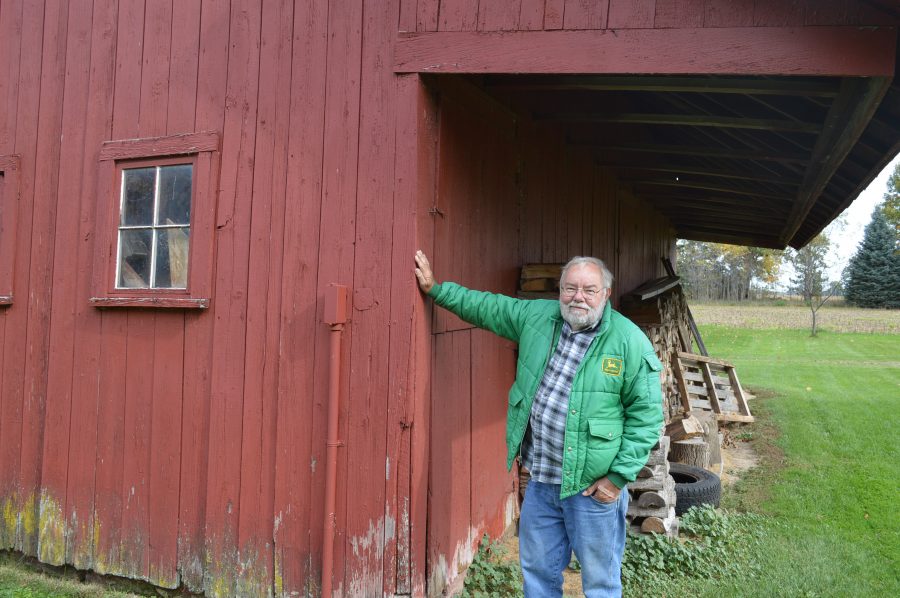Reminders Of A Different Era Of Farming

Mike Noel stands under the overhang of an English barn built in about 1900 on land he owns east of Leesburg. He still uses the barn for storage, but admitted he may decide someday to have the barn torn down.
KOSCIUSKO COUNTY — In a constantly changing world, a constant is the ever changing physical landscape. A drive through the countryside 20 to 30 years ago, depending on the location, would have had considerably different scenery than it does today.
A clear example is a farm. Not only are there fewer of them now, but the buildings or structures found on them have changed. Old wooden barns have sometimes been replaced by larger and taller pole barns. Silos have often been replaced by metal grain bins. Fencing, with some exceptions, has been removed because livestock is often no longer raised on a farm.
Older poultry houses have been supplanted by more modern and efficiently designed buildings. Corn cribs and granaries are often simply no longer needed.
Mike Noel owns farmland east of Leesburg along CR 700N. The land has been owned by his family since 1877. Several reminders of farming’s past still stand on the property, such as an English barn built in about 1900, a drive through corn crib, a smokehouse, a wood house where wood and coal were once stored but later converted into a small garage, split rail fences and a farmhouse built around 1900 too. Noel used to live in the farmhouse, but moved out a couple of years ago and no one is living there now. A few other old buildings were removed years ago.
Noel admitted he is contemplating having the remaining old buildings removed. “The taxes could be a big burden on my kids and grandkids,” he said. “They (buildings) are really no longer usable.”
The barn is still used for storage, but what can be stored inside is limited. “It ends up being a big liability,” he said. Equipment used for farming today is simply too large to fit inside most of the older barns.
Other Farming Remnants
One of the most common farming remnants still standing today is the concrete fence corner post. A few are still used for fencing, but most of them stand alone now. Sometimes, though, they are still used as property markers to distinguish property lines.
Railroad irons once used for fencing can still be found in a few places. Concrete could be poured around the iron and bracing was not needed. Concerning fencing, there was once sort of an unwritten rule for neighboring farm properties the fence to the right was yours to maintain.
Silos were commonly used for storing corn silage, ground ear corn and possibly chopped hay. A few may still be used for something similar now, but more often silos are being torn down.
Chicken houses were much more common generations ago when almost every farm had one because it was more common to raise chickens. Farmers would sometimes then trade the eggs in town. A few of the older chicken houses still stand, but they are either abandoned or have been converted into other uses.
Corn cribs were often used to store ear corn but then it became too big of a summer job to empty those out and take the corn to be shelled at an elevator. Many farmers did this, so there were long lines at the grain elevator. Machinery does the shelling now.
Wooden barns, sometimes built prior to 1900, still stand in some locations today as a reminder of a different era of farming. The Indiana Barn Foundation, and others, are hoping to save as many of these as possible.
But the bottom line eventually comes into the equation and some farmers don’t want to pay the taxes and maintenance costs involved, so the barns are torn down.
- A railroad iron at the intersection of CRs 600S and 400W.
- An old dairy barn with cupolas at the intersection of CRs 700N and 200W.
- A wood house converted into a small garage just off CR 700N, east of Leesburg.
- Concrete fence post on CR 700W, just north of CR 700S.
- An old drive through corn crib at the intersection of CRs 700N and 200W.
- English barn just off CR 700N, east of Leesburg.
- Another drive through corn crib, this one just off CR 700N, east of Leesburg.
- Silo on CR 625S.
- Chicken houses built in the 1950s and no longer used by Creighton Brothers at the intersection of Crystal Lake Road and Parks Schram Road. Also a Quonset hut.









